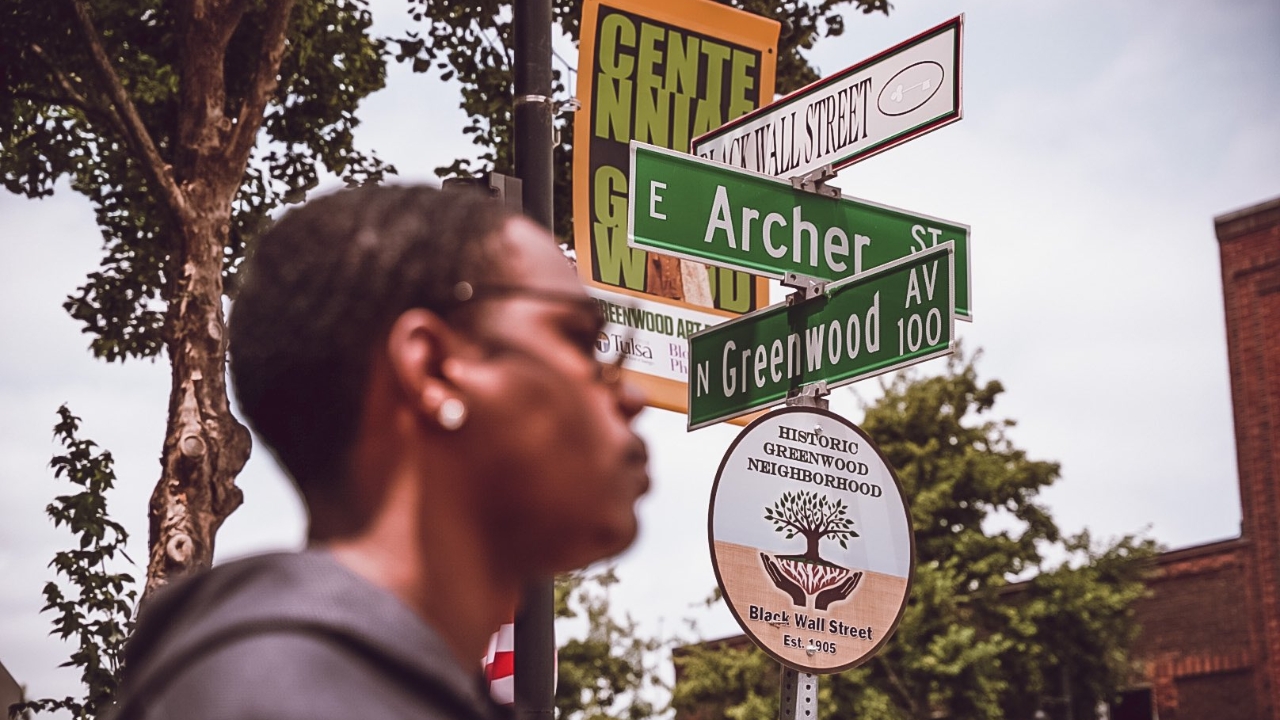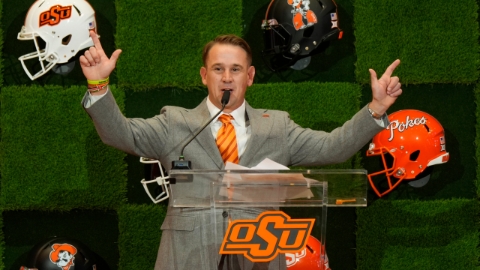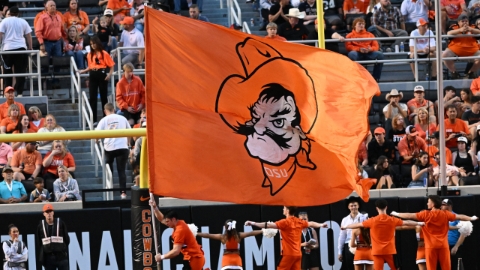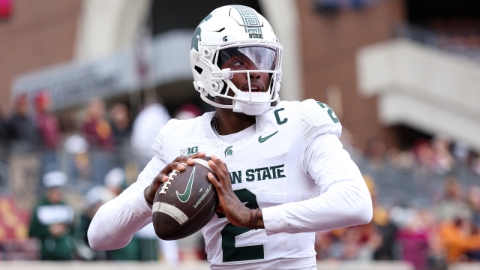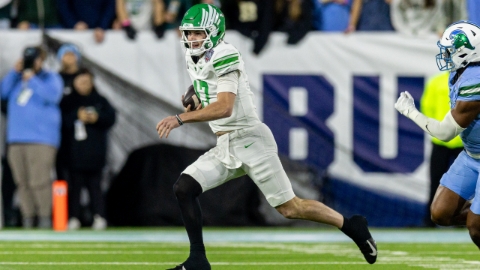STILLWATER – “Yes, very much because you have to listen and envision what the tour guide is talking about,” Oklahoma State football analyst and longtime college football coach Chris Thurmond answered when I asked how locked in the Oklahoma State players were as they toured the location of one of the worst race massacres in United States history and certainly, the worst in Oklahoma. “Our players were really focused on what the presenters were saying. They were paying close attention.”
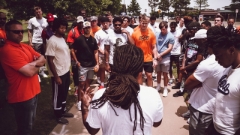
Oklahoma State football
Oklahoma State student-athletes and coaches, including running backs coach John Wozniak on the tour of Black Wall Street.
The corner of Archer and Greenwood Avenues just north of where I-244 runs east and west just north of downtown Tulsa is the start of the area called Black Wall Street. In the days after World War I the oil industry was going strong and things were prosperous in Tulsa. The northeast Oklahoma city was growing and part of Tulsa, which like many cities at that time was segregated, was the Greenwood neighborhood and business district that was home to strong black community that was enjoying success. Black and white lived separately, but mostly peaceful despite a high crime rate in all parts of Tulsa.
On May 30, 1921, a young back man Dirk Rowland entered an elevator downtown in the Drexel Building, the white elevator operator Sarah Page screamed and Rowland fled. The sheriff arrested Rowland the next morning and the Tulsa Tribune printed a story on the afternoon of May 31 that Rowland had been arrested and charged with sexual assault. The vigilante mob justice of the time kicked in as a mob of armed, white men tried to get to Rowland. The sheriff and his deputies defended the young man. A smaller group of armed black men, many World War I veterans offered the sheriff their assistance, but they too were turned away.
They went back to their homes, primarily in the Greenwood District and Black Wall Street. It was there the larger group of white males focused their attention and proceeded to commit acts of violence against Black people, including shooting an unarmed man in a movie theater. The rumors of an uprising by the black community including reinforcements from out of town caused greater hysteria and more violence.
As dawn broke on June 1, thousands of white citizens poured into the Greenwood District, looting and burning homes and businesses over an area of 35 city blocks. Firefighters who arrived to help put out fires later testified that rioters had threatened them with guns and forced them to leave.
This is what happened to Black Wall Street and it’s people.
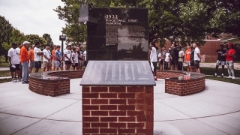
Oklahoma State football
OSU athletes and coaches gather at the memorial for the Tulsa Race Massacre.
“It was almost as if Cody Ransom (tour guide and expert) lived in that time,” Oklahoma State assistant director of football operations Rod Johnson said. “As much as he knew it was like he lived through it.”
“What we’re going to do is we are going to walk Greenwood today. The are we’re going to walk is only about three blocks,” Ransom said to the group as they started the tour. “This is just to conceptualize how big the area was, it was forty blocks.”
Johnson, who should soon have the title of director of football operations was responsible for arranging the bus trip to Tulsa for the history lesson that also included Oklahoma State basketball players and coaches.
“Melvin Gilliam (former Oklahoma State defensive back and Tulsa resident) approached Coach (Gundy) about bringing the players over and having them learn about Black Wall Street,” Johnson told me. “Coach got with me and Coach Glass was involved and we arranged for the tour on Wednesday.”
Wednesday is the usual off day during the week in the summer conditioning program. I would say this past Wednesday was much more than an “off day” it was an enlightening day. Cowboy football players, close to 40 were able to make the bus trip over to learn more about one of the most important events in the state’s history and an event we all need to know about and learn from, primarily that we can never let that kind of anger and hatred exist in our state.
“Coming out here today is a grateful experience. I never knew the things that were going on. I wasn’t educated enough,” super senior cornerback Christian Holmes said. Holmes, a native of Mississippi, no doubt has a lot of knowledge of racial issues as they have permeated history in the south. “I’m grateful to come out here today with my coaches and teammates to learn about this.”
“It means a lot ot me, growing up here, learning about it from my middle school days, and coming back now as a junior in college and bring teammates that are not from here to learn about the black history in Tulsa, Oklahoma and what black culture and what they went through from 1921 until now,” said Tulsa native and Cowboy red-shirt sophomore cornerback Demarco Jones, who graduated from Booker T. Washington High School.
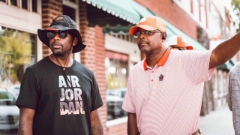
Oklahoma State Basketball
Mike Boynton and Melvin Gilliam
The former Cowboy who brought the idea to Mike Gundy and also basketball head coach Mike Boynton, OSU standout (1985-88) Melvin Gilliam is also a proud alum of Booker T. Washington. He was also a two-sport athlete at Oklahoma State playing football and basketball.
“I’m really glad that you guys came down here to learn about Back Wall Street and the Black Wall Street Massacre. We can’t let history repeat itself,” Gilliams said addressing the players. “The way you do it is to learn about it and you learn from mistakes. You learn and you fix it and you make it better. I really appreciate you guys coming here.”
This is something Oklahoma State fans should be proud of. I’m not going to put a “Disney” touch on this field trip by making it a Remember the Titans or some other analogy of the moment. It is always a positive when Oklahoma State student-athletes go beyond their sport, beyond the campus, and either learn about something important, address a vital issue, or help a group that needs help. All of those have been and are part of the Cowboy football program.
